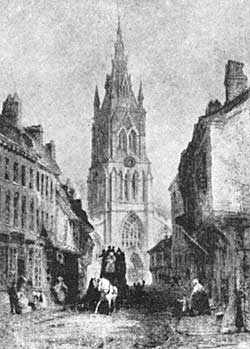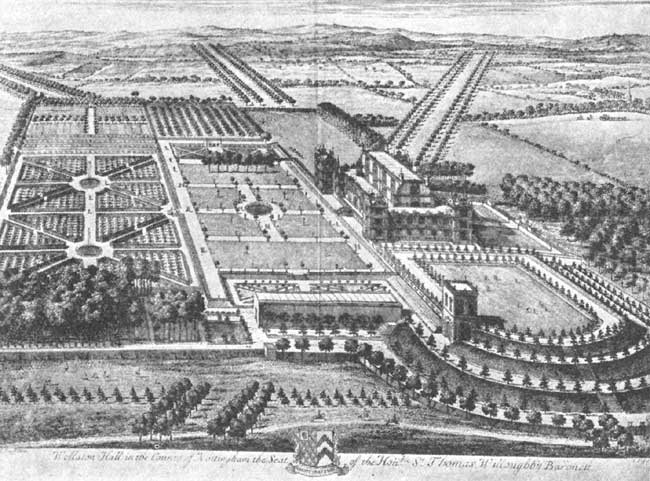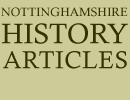Some Nottinghamshire Topographical Views
By Alfred Parker

Newark Church, by Allom.
BROWSING among some volumes the other day I unexpectedly came upon a special edition of "Allom's Views of Nottinghamshire," each of which had been tinted by some previous owner. The charm of some of these decided me to write this month about those artists of past generations who went about the country recording scenes of particular interest.
The idea of the men to whose work I am making reference was the production of plates which could be published and sold either as separate sheets, in folio sets, or combined with descriptive matter in book form.
They were not imaginative painters, for the matter to be dealt with precluded any wide divergence from truth of detail; only in the way of accessories were they able to exercise their powers of invention—such as in peopling the scenes, introducing lighting effects, and such like.
The age of appreciation of English landscape painting had not appeared on the horizon when the Dutchmen, Jan Siberechts and Leonard Knyf came into Nottinghamshire. Such landscape as they were moved to delineate was conceived as a setting for the mansion of some noble patron, much as the scenery in a theatre serves to give atmosphere to the players.
That these earlier men, however, had a much deeper interest in the matter is very evident from the time and care they devoted to its rendition. The large canvases by Siberechts which once adorned the walls of Wollaton Hall proved this beyond doubt, and it has been a puzzle to many writers that, in a country where the majority of the population were so closely associated with the land in one way or another, landscape art should have been so tardy in attracting executants and patrons. Maybe it was just because of their concern with open-air sport, by which a keen sense for the accurate lie of the land is developed, that the wider and yet more intimate statements of its appearance did not appeal for their own sake.
Have we a parallel in the proper appreciation of history—must we to some extent get away from things in order that we may value them at their true worth. At any rate, it was not until an era of manufacture and transformation had set in, when towns were growing, machinery developing, and the country-side being scarred by the construction of canals and coaching roads that the landscape artist, as such, came into his own.
This matter, however, is not our immediate concern. Whatever his precise viewpoint may have been, we are indebted to the Topographical draughtsmen for a great deal of information about our county. The engravings made from their works have preserved a record of the appearance of places as they were in their day, and thus help us to a better understanding of the changes which have taken place since they travelled about the country making their drawings and paintings.
Leonard Knyf, to whom I have already referred, was one of the earliest of these travellers. Born at Haarlem, in 1650, he was forty years of age before he came to London, but between then and his death, in 1721, he made many views of the homes of the gentry and nobility of England.

Wollaton Hall from the drawing by Leonard Knyf, engraved by Kip.
Most of these are bird's-eye views, depicted as if seen from the air, a method requiring a sound knowledge of architectural construction as well as a certain degree of imagination. His Nottinghamshire plates, engraved by Kip, include the two subjects here illustrated and also a view of Nottingham from the east. All of them are graced with the Coat of Arms of the owner of the place illustrated, or the person to whom the plate is dedicated, and this, with the nicely-lettered inscription, adds a decorative quality. The view of Wollaton Hall admirably illustrates the persistence of the mediaeval castle in its underlying plan and is made to stress the long avenues of trees radiating from the house which were a feature of the lay-out of the park; from it we gain an idea of the gardens, as well as of the dress and equipages of the time. The inscription reads:—
"Wollaton Hall, in the County of Nottingham, the seat of the Honble. Sir Thomas Willoughby, Baronet."
The Haughton is by no means so pictorial in effect. The great house in which Sir William Holles once
maintained open house, dispensing hospitality to all comers, is not featured very prominently, and the whole scene has an air of being "much of a muchness." We can, however, appreciate the appearance of the type of park which it was then the fashion to impale about a mansion of the period, in this case without any apparent appreciation of the natural beauties which preceded it, though the situation was very highly commented upon. Beneath we read at length the titles of the owner:—
"Haughton, in the County of Nottingham, one of the seats of the Most Noble and Mighty Prince John, Duke of Newcastle, Marquis and Earl of Clare, Baron Haughton of Haughton, Ld. Lt. of the County of Nottingham and of the Town and County of the Town of Nottingham, Ld. Warden of the Forest of Sherwood and Knight of the Most Noble Order of the Garter," and beneath the Arms the motto: "Spes audaces adiuat."
These engravings of Kip's have more the quality of etching in their general effect, a method used for the plates of Wenceslaus Hollar, who was employed by Charles I, which include the rather severe Southwell Minster with its much maligned "pepper boxes."
Samuel Buck and his brother Nathaniel have a series of nearly 500 plates to their credit. Samuel died in 1779, at the ripe age of 82, and the prints which bear his name, both as draughtsman and engraver, include many places in our county, not only houses of historic interest but such remains as the Rock Holes, now known as the Hermitage, at Nottingham. These smaller impressions were published about 1725-6, when he was in his late twenties, and are very stilted. Not so the large plates which the brothers produce jointly. These are enlivened with groups of figures and incidents which instil a certain liveliness to the scene.
The fashion for arms and eulogies still prevailing, we find the South Prospect of Worksop dedicated to Edward, Duke of Norfolk, Hereditary Earl Marshal of England, Earl of Arundel, Surrey, Norfolk and Norwich, Baron Howard of Mowbray, etc., Premier Duke, Earl and Baron of England, next the Blood Royal, and chief of the illustrious family of Howard.
These larger plates bear date twenty years later than those of Samuel, the best known of the series being the South View of Nottingham, popularized by frequent reproduction, and is similar in many respects to the well-known plate from Thomas Sandby's drawing, dated 1742, and used to illustrate Dr. Deering's "History of Nottingham."
